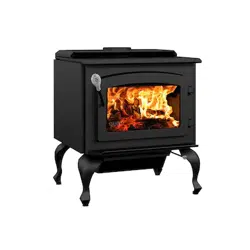Loading ...
Loading ...
Loading ...

Installation and Operation Manual for Escape 1800
46
The rules below are based on those found in the CSA B365 installation code. Please
carefully follow these installation instruction rules, or those enforced where you live.
• Maximum overall length of straight pipe: 3 m (10 ft.) including elbows.
• Minimum clearance from combustible material: 450 mm (18 in.). The minimum clearance
may be reduced by 50 percent to 225 mm (9 in.) if suitable shielding is installed either
on the pipe or on the combustible surface.
• The assembly should be as short and direct as possible between the stove and chimney.
The use of two 45° elbows is often preferable to a single 90° elbow because less
turbulence is created in the exhaust flow and they result in less horizontal run.
• Maximum number of 90° elbows: 2.
• Maximum unsupported horizontal length: 1 m (3 feet).
• Galvanized flue pipes must not be used because the coatings vaporize at high
temperatures and release dangerous gases. Use black painted flue pipes.
• Flue pipes must be at least 24 gauge in thickness.
• Flue pipe joints should overlap 30 mm (1 1/4 in.)
• Each joint in the assembly must be fastened with at least three screws.
• The assembly must have allowance for expansion: elbows in assemblies allow for
expansion; straight assemblies should include an inspection wrap with one end
unfastened, or a telescopic section.
• Minimum upward slope towards the chimney: 20 mm/m (1/4 in/ft.).
• One end of the assembly must be securely fastened to the flue collar with 3 sheet metal
screws and the other end securely fastened to the chimney.
• There must be provision for cleaning of the pipes, either through a clean out or by
removal of the pipe assembly. Removal of the assembly should not require that the stove
be moved.
• The male ends of the sections must be oriented towards the appliance so that falling dust
and condensation stay inside the pipe.
• A flue pipe must never pass through a combustible floor or ceiling or through an attic,
roof space, closet or concealed space.
• Where passage through a wall or partition of combustible construction is desired, the
installation shall conform to CAN/CSA-B365, Installation Code for Solid-Fuel-Burning
Appliances and Equipment.
The ideal flue pipe assembly is one that rises straight up from the appliance flue collar and
directly into the chimney with no elbows. A straight up connector assembly needs either a
telescopic length or an inspection wrap (pipe coupler) to allow it to be assembled and
disassembled without moving the stove.
A straight flue pipe assembly offers the least restriction to gas flow and results in a stronger
draft. Straight assemblies also need less maintenance because there are no corners to
collect creosote.
The chimney connector must be in good condition.
Loading ...
Loading ...
Loading ...
